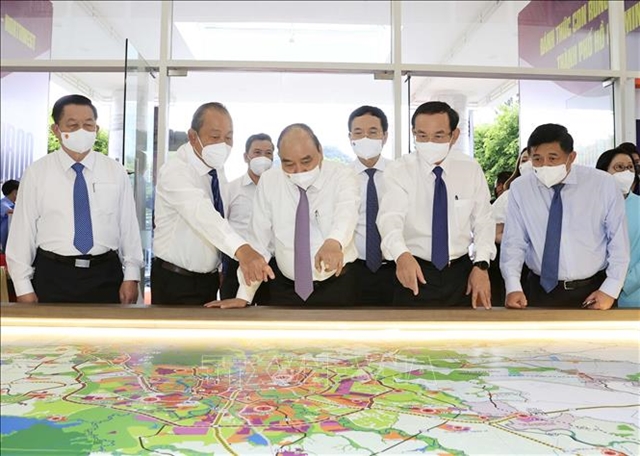 Economy
Economy


|
| President Nguyễn Xuân Phúc (third from left) looks at the planning map of two suburban districts of Hóc Môn and Củ Chi. VNA/VNS Photo Thống Nhất |
HCM CITY — President Nguyễn Xuân Phúc has urged the suburban districts of Củ Chi and Hóc Môn in HCM City to review all public investment projects, especially their feasibility, and improve the business climate to attract investment.
Speaking at a conference to promote investment in Củ Chi and Hóc Môn on Tuesday, Phúc said the city should promote investment in the two suburban districts as part of the plan to develop the city further to the northwest, creating long-term livelihoods for residents and developing new sustainable urban areas.
He said Hóc Môn and Củ Chi would provide new growth for HCM City, adding that it was important to carefully select projects to call for investment that could optimise the potential and advantages of the two suburban districts.
To achieve this goal, Phúc ordered the two districts to improve state management in all fields, including the fight against corruption and wastefulness.
They must also work to improve the business climate to solicit investment in developing new urban areas, industrial parks, tourist areas and commercial zones.
Hóc Môn and Củ Chi are calling for investment in 55 projects worth a total of VNĐ285 trillion (US$12.46 billion) in infrastructure, industry, high-tech agriculture, trade-service, education-culture-sport and transport.
Phúc has demanded the districts balance economic development benefits with environmental protection, urging them to address issues related to waste treatment and housing for workers.
“Urbanisation of the two suburban districts must meet environmental and ecological criteria,” Phúc said.
He also asked the suburban districts to tackle any hurdles related to transport infrastructure and create the most favourable conditions for investors.
Củ Chi to achieve city status
Củ Chi has been urged by the city's People’s Council to develop a plan to become a city, under the jurisdiction of HCM City.
Củ Chi, which borders Hóc Môn District and the provinces of Bình Dương, Tây Ninh and Long An, aims to become a logistics hub connecting industrial zones in Bình Dương, Tây Ninh and Long An.
Some investors had already shown interest in developing five-star nursing home facilities that offer high-end medical and health care services in Củ Chi.
Nguyễn Văn Nên, secretary of the HCM City Party Committee, said Củ Chi must speed up major projects like the Tây Bắc (northwest) urban area and the Saigon Zoo and Botanical Garden.
The expressway from An Sương to Mộc Bài and Ring Road No. 3 should be accelerated to link Củ Chi and Hóc Môn districts with the eastern part of HCM City and Đồng Nai Province, he said.
The possibility of having roads running along the Đồng Nai River to Củ Chi should be studied in order to shorten the travel time and develop ecotourism, he added.
HCM City authorities also announced a plan to speed up the urbanisation of Củ Chi, Hóc Môn, Bình Chánh, Nhà Bè and Cần Giờ in order to make them urban districts by 2030.
All the districts have seen rapid urbanisation in recent years, with the creation of new urban areas, construction of expressways and improved lifestyles.
Criteria such as population, area, socio-economic indicators, education levels and urban infrastructure apply for becoming an urban district.
However, the plan has already triggered a “land fever” in the suburban areas.
Land prices in some areas in Củ Chi and Hóc Môn, for example, have surged recently (by between 30 and 100 per cent).
Hóc Môn is spread over more than 109 square kilometres and has a population of nearly 463,000. The corresponding figures are 435sq.km and 468,000 for Củ Chi, 252sq.km and 711,000 for Bình Chánh, 100sq.km and 208,000 for Nhà Bè, 435sq.km and 468,000 for Củ Chi, and 704sq.km and 73,000 for Cần Giờ. — VNS




